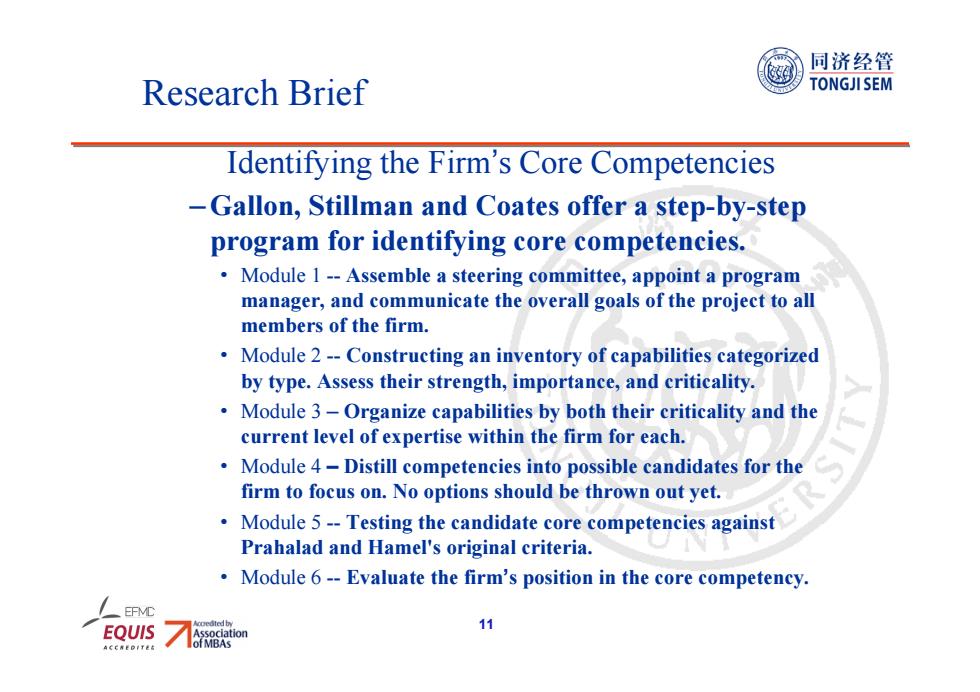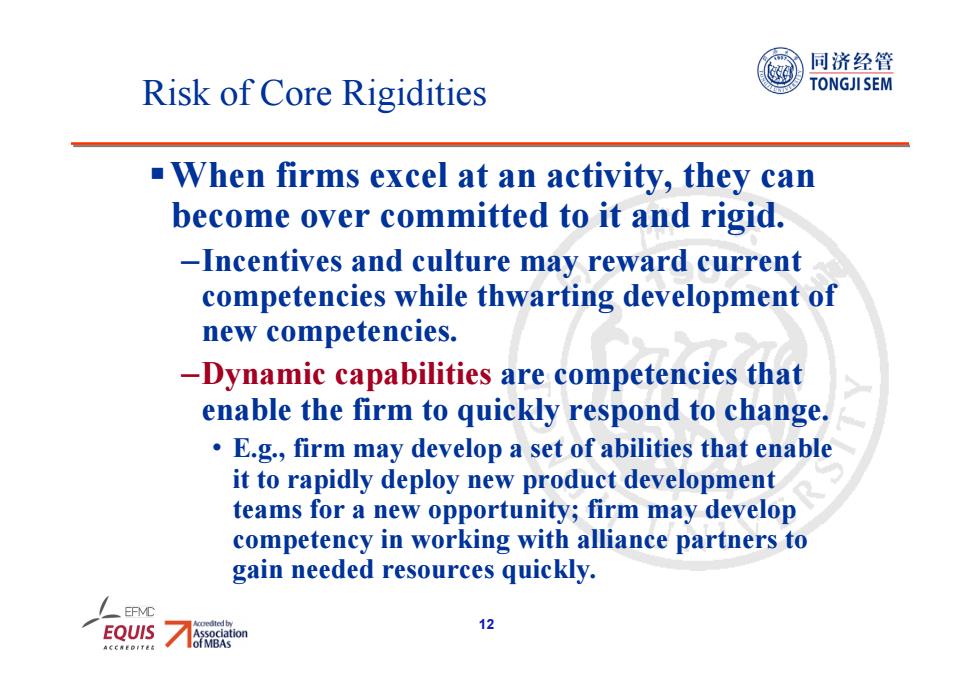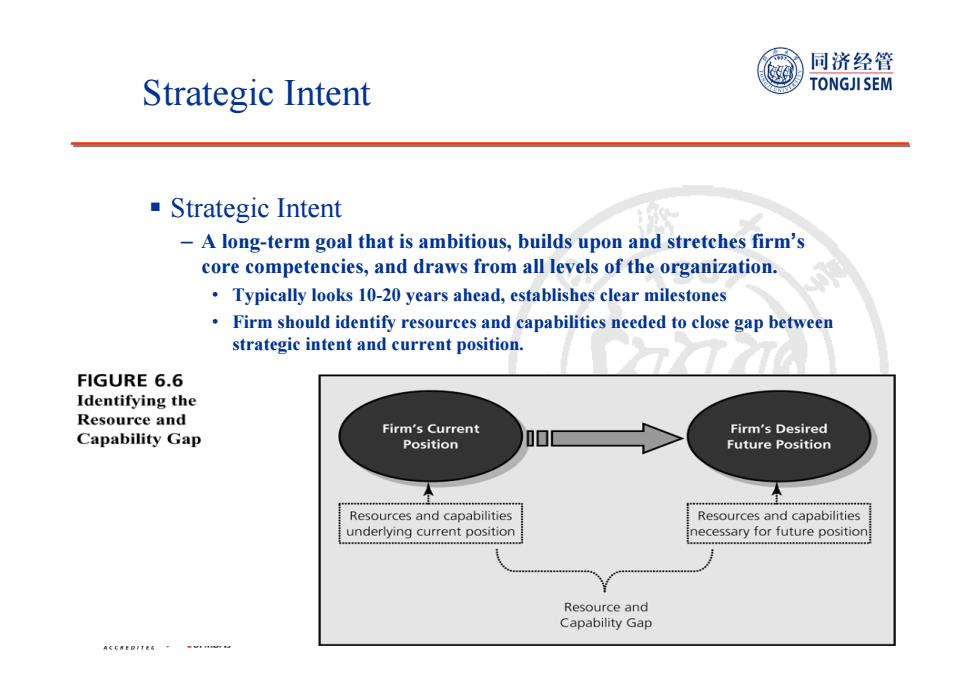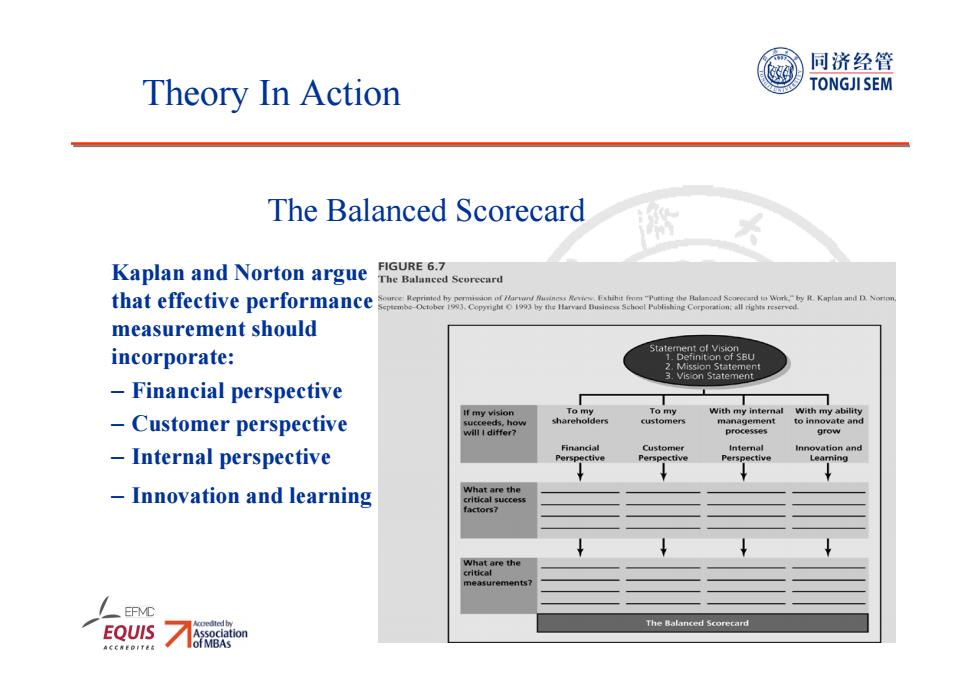
同济经管 Research Brief TONGJI SEM Identifying the Firm's Core Competencies -Gallon,Stillman and Coates offer a step-by-step program for identifying core competencies. Module 1--Assemble a steering committee,appoint a program manager,and communicate the overall goals of the project to all members of the firm. Module 2--Constructing an inventory of capabilities categorized by type.Assess their strength,importance,and criticality. Module 3-Organize capabilities by both their criticality and the current level of expertise within the firm for each. Module 4-Distill competencies into possible candidates for the firm to focus on.No options should be thrown out yet. Module 5--Testing the candidate core competencies against Prahalad and Hamel's original criteria. Module 6--Evaluate the firm's position in the core competency. EQUIS 11
11 Identifying the Firm’s Core Competencies –Gallon, Stillman and Coates offer a step-by-step program for identifying core competencies. • Module 1 -- Assemble a steering committee, appoint a program manager, and communicate the overall goals of the project to all members of the firm. • Module 2 -- Constructing an inventory of capabilities categorized by type. Assess their strength, importance, and criticality. • Module 3 – Organize capabilities by both their criticality and the current level of expertise within the firm for each. • Module 4 – Distill competencies into possible candidates for the firm to focus on. No options should be thrown out yet. • Module 5 -- Testing the candidate core competencies against Prahalad and Hamel's original criteria. • Module 6 -- Evaluate the firm’s position in the core competency. Research Brief

同济经管 Risk of Core Rigidities TONGJI SEM -When firms excel at an activity,they can become over committed to it and rigid. -Incentives and culture may reward current competencies while thwarting development of new competencies. -Dynamic capabilities are competencies that enable the firm to quickly respond to change. E.g.,firm may develop a set of abilities that enable it to rapidly deploy new product development teams for a new opportunity;firm may develop competency in working with alliance partners to gain needed resources quickly. EQUIS 12
12 Risk of Core Rigidities When firms excel at an activity, they can become over committed to it and rigid. –Incentives and culture may reward current competencies while thwarting development of new competencies. –Dynamic capabilities are competencies that enable the firm to quickly respond to change. • E.g., firm may develop a set of abilities that enable it to rapidly deploy new product development teams for a new opportunity; firm may develop competency in working with alliance partners to gain needed resources quickly

同济经管 Strategic Intent TONGJI SEM ■Strategic Intent -A long-term goal that is ambitious,builds upon and stretches firm's core competencies,and draws from all levels of the organization. Typically looks 10-20 years ahead,establishes clear milestones Firm should identify resources and capabilities needed to close gap between strategic intent and current position. FIGURE 6.6 Identifying the Resource and Firm's Current Firm's Desired Capability Gap Position Future Position Resources and capabilities Resources and capabilities underlying current position inecessary for future position Resource and Capability Gap
13 Strategic Intent Strategic Intent – A long-term goal that is ambitious, builds upon and stretches firm’s core competencies, and draws from all levels of the organization. • Typically looks 10-20 years ahead, establishes clear milestones • Firm should identify resources and capabilities needed to close gap between strategic intent and current position

同济经管 Theory In Action TONGJI SEM The Balanced Scorecard Kaplan and Norton argue The Balanced Scorecard that effective performance measurement should incorporate: Vision Statement -Financial perspective If my vision Customer perspective Internal perspective Innovation and learning What are the What are the tical ents EFMC EQUIS The Balanced Scorecard
14 Theory In Action The Balanced Scorecard Kaplan and Norton argue that effective performance measurement should incorporate: – Financial perspective – Customer perspective – Internal perspective – Innovation and learning

同济经管 Discussion Questions TONGJI SEM 1.What is the difference between a strength,a competitive advantage, and a sustainable competitive advantage? 2.What makes an ability (or set of abilities)a core competency? 3.Why is it necessary to perform an external and internal analysis before the firm can identify its true core competencies? 4.Pick a company you are familiar with.Can you identify some of its core competencies? 5.How is the idea of"strategic intent"different from models of strategy that emphasize achieving a fit between the firm's strategies and its current strengths,weaknesses,opportunities and threats(SWOT)? 6. Can a strategic intent be too ambitious? LVC EQUIS 15
15 Discussion Questions 1. What is the difference between a strength, a competitive advantage, and a sustainable competitive advantage? 2. What makes an ability (or set of abilities) a core competency? 3. Why is it necessary to perform an external and internal analysis before the firm can identify its true core competencies? 4. Pick a company you are familiar with. Can you identify some of its core competencies? 5. How is the idea of “strategic intent” different from models of strategy that emphasize achieving a fit between the firm’s strategies and its current strengths, weaknesses, opportunities and threats (SWOT)? 6. Can a strategic intent be too ambitious?